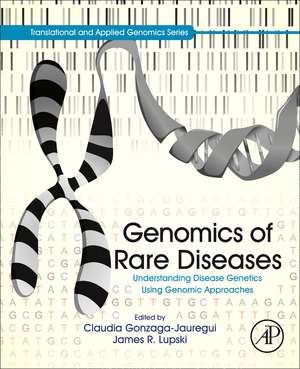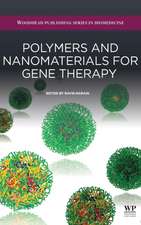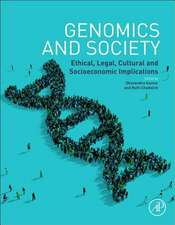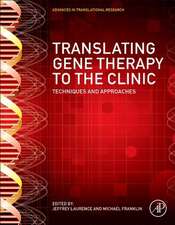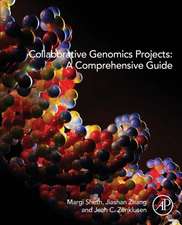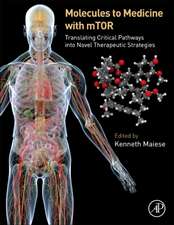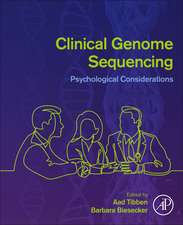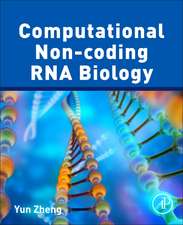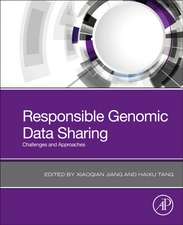Genomics of Rare Diseases: Understanding Disease Genetics Using Genomic Approaches: Translational and Applied Genomics
Editat de Claudia Gonzaga-Jauregui, James R. Lupskien Limba Engleză Paperback – 24 iun 2021
Leading chapter authors in the field discuss approaches such as karyotyping and genomic sequencing for the better diagnosis and treatment of conditions including recessive diseases, dominant and X-linked disorders, de novo mutations, sporadic disorders and mosaicism.
- Compiles applied case studies and methodologies, enabling researchers, clinicians and healthcare providers to effectively classify DNA variants associated with disease and patient phenotypes
- Discusses the main challenges in studying the genetics of rare diseases through genomic approaches and possible or ongoing solutions
- Explores opportunities for novel therapeutics
- Features chapter contributions from leading researchers and clinicians
Preț: 807.93 lei
Preț vechi: 985.29 lei
-18% Nou
Puncte Express: 1212
Preț estimativ în valută:
154.62€ • 167.89$ • 129.88£
154.62€ • 167.89$ • 129.88£
Carte disponibilă
Livrare economică 01-15 aprilie
Livrare express 18-22 martie pentru 37.79 lei
Preluare comenzi: 021 569.72.76
Specificații
ISBN-13: 9780128201404
ISBN-10: 0128201401
Pagini: 316
Ilustrații: 60 illustrations (40 in full color)
Dimensiuni: 191 x 235 x 24 mm
Greutate: 0.65 kg
Editura: ELSEVIER SCIENCE
Seria Translational and Applied Genomics
ISBN-10: 0128201401
Pagini: 316
Ilustrații: 60 illustrations (40 in full color)
Dimensiuni: 191 x 235 x 24 mm
Greutate: 0.65 kg
Editura: ELSEVIER SCIENCE
Seria Translational and Applied Genomics
Public țintă
Active researchers; basic and translational scientists; clinicians in the areas of rare disease, human genetics, human genomics; translational researchers in genetic and genomic medicine, epigenetics, neuroscience, internal medicine, oncology, psychiatry, neurology, immunology, embryology, endocrinology, bioinformatics, prenatal testing, psychology, psychiatry, and genetic testing; genetic counselors; rare disease specialists; fertility specialists; bioethicists; hospital administratorsCuprins
1. Introduction to concepts of genetics and genomics
2. Karyotyping as the first genomic approach
3. Genomic disorders
4. Genomic sequencing of rare diseases
5. Recessive diseases and founder genetics
6. Dominant and de novo disorders
7. X-linked and mitochondrial disorders
8. Mosaicism in rare disease
9. Dual diagnoses of rare disorders
10. Statistical approaches to rare disease analyses
11. Transcriptomics in rare diseases
12. Other omics approaches to the study of rare diseases
13. Challenges and opportunities in rare diseases research
2. Karyotyping as the first genomic approach
3. Genomic disorders
4. Genomic sequencing of rare diseases
5. Recessive diseases and founder genetics
6. Dominant and de novo disorders
7. X-linked and mitochondrial disorders
8. Mosaicism in rare disease
9. Dual diagnoses of rare disorders
10. Statistical approaches to rare disease analyses
11. Transcriptomics in rare diseases
12. Other omics approaches to the study of rare diseases
13. Challenges and opportunities in rare diseases research
Recenzii
"This timely and well-written book is a useful addition to a dynamic field of study that has changed markedly over the last two decades. It provides an accurate picture of the current state of genomics as applied to the study of human hereditary disease. The field will continue its rapid evolution, and this book provides a way for a variety scientists and medical practitioners to gain entry into the field, whether for the purpose of research or the practice of medicine." --© Doody Review, 2021, Mark F. Sanders, PhD, reviewer, expert opinion
"This is an exceptional book for clinicians, clinical laboratorians, and clinical researchers at many different levels. It employs specific diseases and phenotypes to illustrate important genetic concepts and educate about laboratory approaches to genetic diagnosis and gene discovery. The chapters are succinct and well-organized, and the many color illustrations enhance the readers’ comprehension of even the most arcane and complex genetic and genomic phenomena. Similarly, chapters on the laboratory approach to diagnosis provide practical information on various genetic and genomic platforms and describe the underlying technologies, providing the reader the tools to understand and apply genomic analyses in both the clinical and research setting ." -- V. Reid Sutton, M.D., Professor of Molecular & Human Genetics, Baylor College of Medicine
"This is an exceptional book for clinicians, clinical laboratorians, and clinical researchers at many different levels. It employs specific diseases and phenotypes to illustrate important genetic concepts and educate about laboratory approaches to genetic diagnosis and gene discovery. The chapters are succinct and well-organized, and the many color illustrations enhance the readers’ comprehension of even the most arcane and complex genetic and genomic phenomena. Similarly, chapters on the laboratory approach to diagnosis provide practical information on various genetic and genomic platforms and describe the underlying technologies, providing the reader the tools to understand and apply genomic analyses in both the clinical and research setting ." -- V. Reid Sutton, M.D., Professor of Molecular & Human Genetics, Baylor College of Medicine
